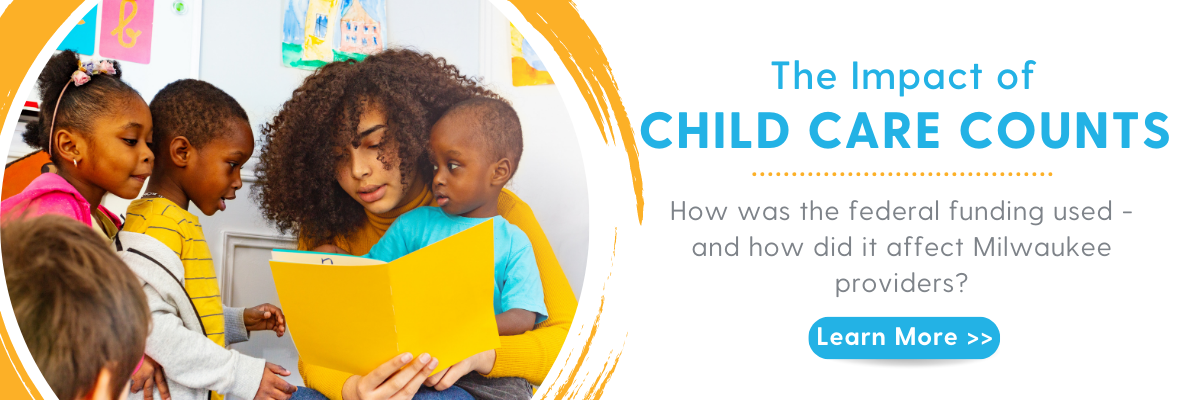‘We Need This’: Child Care Counts Survey Reveals the Impact of Federal Funding
“[Child Care Counts funding] saved us. We would have shut our doors and turned away 66 families that all have parents that need to work.”
Those powerful words arose from the recent Child Care Counts survey conducted this spring by the Milwaukee Succeeds-led Early Childhood Education (ECE) Coalition. From helping providers retain staff in a difficult job market to allowing them to pay their mortgage and afford utilities, it’s clear that the federal funding has had an enormous impact on the sector.
The new data, which was published in a report titled “Making Every Dollar Count,” highlights the ongoing impacts of the funding, while underscoring the need for continued investment into the industry.
What is Child Care Counts?
The ECE sector has been under strain for years, with COVID only intensifying these challenges. Providers were asked to remain open to serve the children of essential workers, and they did so while confronting decreased revenue and increased expenses for health and safety protocols. Without financial assistance, approximately 40% of Milwaukee providers would have permanently closed.
The state of Wisconsin developed Child Care Counts in response to these challenges. The program, which began in March 2020 and will continue through 2023, allocates federal COVID relief dollars to child care providers to help them stay open, keep staff employed and provide quality care. As of March 2022, over $62 million had been awarded to more than 1,300 providers in Milwaukee.
In order to assess what impact this funding has had, Milwaukee’s ECE Coalition sprang into action, creating a digital survey that went out to all providers in the city. With a 44% response rate (507 total responses), the survey provides a clear picture of the significant benefits that Child Care Counts has had on the industry, as well as outlining the challenges that still remain.
What impact did it have for providers?
“I was at a place where I honestly didn’t know where the next dollar was coming from, and it was super stressful,” says Porcha Brown, program director of Inetter’s Blooming Roses Family Child Care. “[This funding] was so very helpful when it did come about to help me stay afloat, keep the rent paid, keep getting those activities and things the children need monthly.”
Porcha’s experience echoes that of providers throughout the city, whose businesses were bolstered by the influx of funds. Specifically, respondents indicated that Child Care Counts had a noticeable impact on staff compensation/benefits, being able to pay their bills and expenses, purchasing supplies and equipment and, ultimately, allowing them to stay open during these challenging times.
For Tamara Summerville, program director at Summerville Learning and Development Center, the positive effects of this funding will be felt for years to come.
“Those funds really enabled me to do a lot of things as far as helping increase high-quality care at my site,” she says. “And that’s going to have lots of impacts down the road.”
How did providers used the funds?
When providers were asked about the specific ways they used the funding, several themes emerged:
About 80% used funding for cleaning and/or classroom supplies, while 75% used it on utilities, 70% for rent or mortgage, and 66% for personal protective equipment.
For funds designated for staffing needs, over half used them to provide a one-time stipend or bonus, while over 40% used it for professional development or pay raises.
Six out of ten providers reduced fees for parents, citing it as a way to support families financially and provide relief during the pandemic.
Porcha purchased new STEM toys, learning activities and outdoor equipment, allowing children the opportunity to “continue to explore and learn in the way they deserve to.”
Similarly, Tamara brought in new curriculum and educational toys, as well as updating her center and investing in teacher trainings. In addition, both women saw that their families were struggling to afford the cost of care and decided to remove some of that burden by reducing the parent share in some way.
What needs remain?
“I’m still struggling,” admits Porcha. “I know I’m not the only one.”
While some providers were able to meet their core needs, others – like Porcha – still have concerns. Top amongst these relates to staff compensation and benefits, as well as recruitment and retention.
According to recent data, ECE centers in Milwaukee can only afford to pay their teachers an average of $13/hour. At a big box store, they could make upwards of $15/hour.
“Staff compensation and being able to provide additional benefits, like health insurance or paid time off, is really important to providers,” says Kristin Kappelman, director of research for Milwaukee Succeeds. “This is a very competitive job market, and providers highlighted that they had a difficult time finding qualified staff – and an even harder time actually retaining that staff.”
Other lingering needs included building infrastructure, such as renovations, and additional supplies and equipment, like office materials, new curriculum or toys.
“It helped with the supplies, but it didn’t cover everything,” mentioned one provider. “I still had to pull it out of my pocket to do more, and that’s with everything – food, utilities, cleaning supplies.”
What would providers tell decision-makers?
“I couldn’t be more thankful,” says Porcha.
The theme of gratitude was common among respondents, who took the opportunity to reinforce the fact that these funds helped keep their businesses open and increase the quality of their programming.
“Providers wanted to say thank you to decision-makers and elected officials for thinking of them, and for making sure child care was included in this payment process,” says Kristin. “But they’re also worried about what will happen next.”
Simply put, providers want the funding to continue. They want the stability to be able to retain staff and continue cutting fees for parents. And they want the peace of mind that comes from knowing that their business will be able to remain open, despite the challenges.
“If we continue to get funding,” says Tamara, “we can see some of those high co-payments reduced for parents. We can get more qualified workers. That’s what I would tell, decision makers: We need this.”
Next Steps
Kristin hopes that this survey is only the beginning, with other communities throughout Wisconsin joining in to conduct similar studies. Obtaining such data would provide a larger-scale picture of how Child Care Counts has impacted providers throughout the state, facilitating a discussion on the state of ECE in Wisconsin.
The data also serves as an opportunity for individuals to learn more about how federal funding has impacted a subsection of the workforce, as well as the need for continued investment. For Milwaukee’s ECE Coalition, this information represents a crucial tool in their ongoing efforts to advocate for much needed, much deserved funding into this vital sector.




